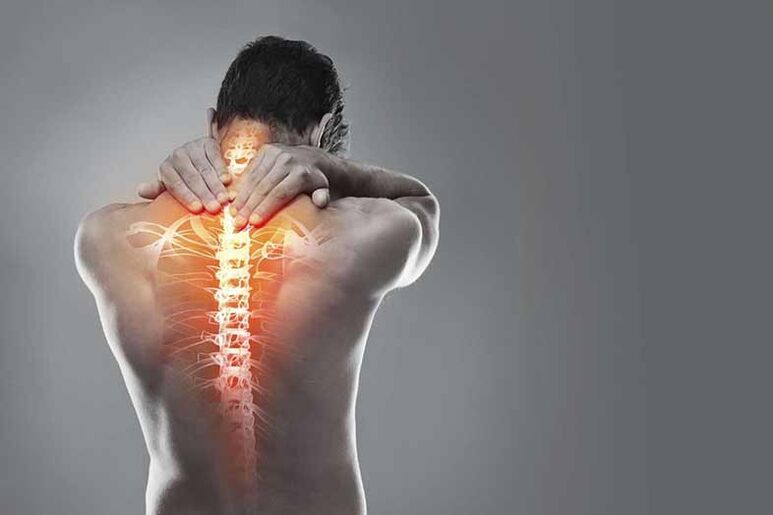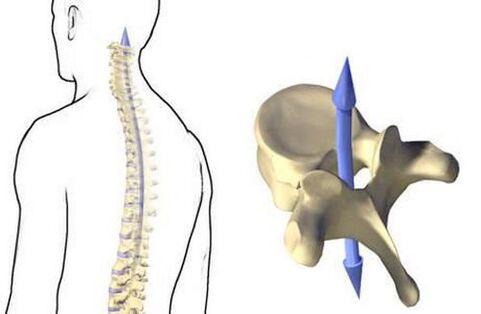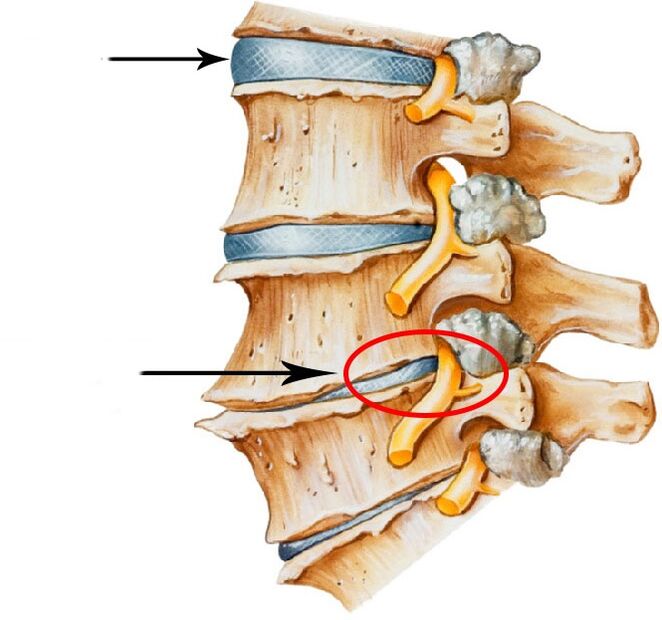
According to statistics, nearly half of people already suffer from osteochondrosis already from 30 to 55 years old.The lower threshold of the age of the disease has declined to 18 years in recent years.
What is osteohandrosis
Osteochondrosis of the spineIt is expressed in the damage of the intervertebral disc, which loses its elasticity, elasticity, cracks.
Cervical osteochondrosisassociated with damage to the discs in the cervical spine.
How does the spine work
If, for a better understanding, the essence is a little simplified, then the spine device can be described as follows.
The spine consists of separate ones, similar to each other in the form of vertebrae located one above the other.
Despite some differences in the form, the structure of all vertebrae is common.There is a hole in each vertebra - all holes are also above the other and form a vertical canal (tunnel) passing throughout the spine.
The spinal cord passes into this spinal canal.It passes vertically through the holes in each vertebra, and its roots (branches in which sensitive nerve endings) leave the channel between each pair of vertebrae.This is possible because the vertebrae are not lost to each other and are not fastened tightly, and there is cartilage between each pair of vertebrae - intervertebral disc.

The wheels together with the ligaments connect the vertebrae and also play the role of the shock absorber.Due to their elastic structure, they are elastic compressed during the movements and slopes of the body (on the slope side) or untreated (when straightened).In this way, the discs provide the spine flexibility and soften the load from the vertical pressure from the top to the bottom to each vertebra of the spine, as well as the upward vibrations that appear when walking or running.After all, one is a unique and clear creature.
Such spinal work is guaranteed if the whole load is properly distributed.Nature has created the spine incredibly stable, durable and at the same time flexible.
And if not?
If the shape of the spine, conceived by nature, for some reason it is disturbed (stop, excessive bend in the lower back, scoliosis, flat legs) or a constant chronic habit of sitting, lying, intervertebral compoundThey stick to the side, forming hernia.
Wear of the intervertebral discs - there is also a person's consideration of a person.After all, only in humans the spine has a vertical load.Such a vertical lifelong compression of all components of the spine (especially in people with excess weight) leads to a gradual deterioration of the blood supply to the intervertebral discs (the vascular direction is pressed) - the disc loses endurance and strength.
What is next?

Hernias pressureBlood vessels.,Nerve rootsand sometimesspinal cordS
The effects of cervical osteochondrosis
Due to changes in the anatomical ratios in the spine, blood vessels (main arteries and veins) are pressed.
What happens:Due to changes in the anatomical ratios in the spine, blood vessels (main arteries and veins) are pressed.What leads to:
- to a violation of blood flow to the brain and disorder of complete nutrition of the brain.
- to impaired venous outflow and the accumulation of toxic substances in the tissues of the brain.
How it manifests itself:
- Dizziness (to short -term loss of consciousness).
- Headache.
- Visual damage.Odor disorder, taste.
- Bulbari disorders related to the difficulties of swallowing, pronunciation, disruption of general and speech breathing.
- Cognitive disorders: impaired memory, perception, complexity with concentration of attention, complexity with logical thinking.Reading violation.
- Absent -de exchange.Inappropriately.Reducing confusion.Forget.
- Difficulties in pronouncing complex and long words, complex grammatical structures.
- Reduced efficiency, fatigue.
- Disorders of the emotional and personal sphere: acute and unreasonable changes in mood, emotional incontinence, irritability, anger.
Diagnoses: Cognitive disorders, aphasia, Bulbar dysarthria, discardial encephalopathy, vertebral insufficiency (VBN) and others can be diagnosed. Medicine therapy taken in these cases:
- Vascular medicines.They have an extremely low base of evidence.They require the use of the doctor and under the supervision of a doctor, they can cause a large number of different complications and side effects.
- Nootropic drugs.Require to use the appointment strictly under your doctor's control.Many have quite serious contraindications from the cardiovascular system (with hidden cardiac pathology can have serious negative effects).Most of the nootropes do not have a positive pharmacological result, that is, it is useless.
- Sedative drugs, including tranquilizers, antidepressants, barbiturates, bromides.Psychotropic drugs.Require to use the appointment strictly under your doctor's control.They can be addictive and have multiple side effects (dizziness, headache, visual impairment and urination, dry mouth, nausea, etc. disorders of disgrace, reduction of libido, sleep disorders, body weight).
There is a compression (compression) of the nerve roots - nerves coming from the spinal cord to the organs and tissues of the upper body.
What happens:
There is a compression (compression) of the nerve roots - nerves coming from the spinal cord to the organs and tissues of the upper body.
What leads to: To pronounced pain syndrome, often chronic, recurrent.
How it manifests itself:
- Neck pain, back of the head (with turns on the head or at rest, shots or chronic).
- Headache (headache of tension associated with the tension of the muscles of the posterior surface of the neck and head of the head - pain poured over the entire head, often accompanied by noise and ringing in the ears, flies in front of the eyes).
- Pain in the upper chest.
- Pain that simulates heart pain, lungs.
- Upper back pain in the shoulders, shoulders.
- Pain in the shoulder joint or throughout the hand.
- Tingling of the fingers, arms, hands completely.
Medicine therapy taken in these cases:
- Non-steroidal anti-inflammatory drugs (painkillers, antipyretic) requiring the use of strictly for the appointment and control of a doctor and have side negative reactions from the gastrointestinal tract (gastritis, ulcers, ulcer), cardiovascular system, kidneys.
- Preparations that relieve muscle hypertension requiring use strictly for its purpose and under the control of a doctor and have lateral negative reactions in the form of severe dizziness, weakness to completely exhausting.
The use of drug therapy is the most common practice in the treatment of osteochondrosis.However, this is symptomatic treatment.Medicines are used to stop inflammatory processes and pain (sometimes you need to resort to blockade of novocaine), reducing neurological and psycho -emotional symptoms.Most importantly, pharmacological therapy is found under the strict supervision of a doctor.
However, if you do not directly stop the process of the violation of the vessels, do not restore the balance of the spine and all related structures Laid -up (Violation of the Symmetry of the Body, FLATCompensatory Reaction to Equilibrium), The Disease Will Not Go Anywher and at Some Point It Dos Not Help and Should Not Help and Should Resort To The Operation.
Osteopathic treatment is aimed at eliminating the above causes of osteochondrosis, which is today recognized as the most effective.
Osteopathic treatment of osteohandrosis
Rule # 1 "The earlier, the better" in the case of osteochondrosis, it works especially!After all, cure osteochondrosis - means not extinguishing pain or other syndromes, but to restore the normal position of the spine, to ensure the intervertebral disc with a lost full meal (to return normal blood supply), even before the degenerative processes in the cartilage.
The osteopath determines the place in which the displacement or deformation has occurred, finds findsThe reasons why the vessels of the vessels in the spine occurSOsteopathy views the body as a single system in which everything is connected and affects each other, literally pulling one after the other.This means that osteopath restores the work of all structures, the changes in which in the chain have led to a violation of the power of the intervertebral disc.The task of the osteopath is to restore the balance of equilibrium of organs and tissues, to eliminate tensions and clamps that prevent full meal.And if, in the case of a neglected condition of the disease, changes in the structure of the spine led to a violation of the work of the internal organs, osteopathic treatment will be aimed at eliminating the occurrence of occurring dysfunctions.
That is, the osteopath works with the root cause of the disease, not the elimination of its syndromes, including pain.Although it will start working with this, with pain relief.However, this will not stop there.The best way to osteopathy works in combination with physiotherapy (guarantees a decrease in pain and inflammatory processes) and physiotherapy exercises - exercise therapy (strengthens the muscle corset, helps the body remain in a new unusual but appropriate position).
Conclusions
- The neck cannot be treated frivolously.Because the brain must be provided with unobstructed nutrition.And it depends on how much the neck is a "conductor".
- You can't wait.The more the disease is fired, the more difficult it is to take it back (and sometimes impossible).Osteopath is able to determine the disease when it is still in the rudiment and does not manifest itself in any way.You should never neglect a diagnostic examination.
- It is impossible to ignore the prevention of osteochondrosis.It is always easier than treating the disease.

























